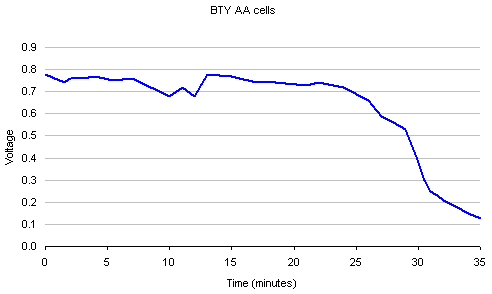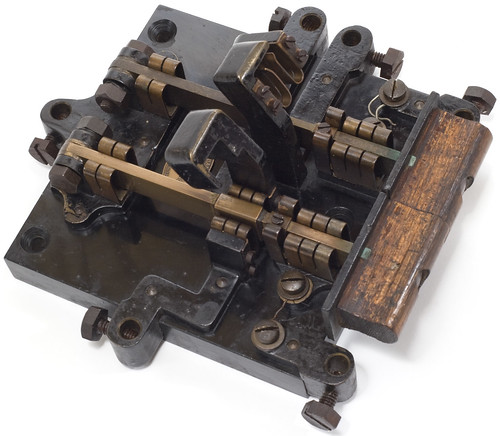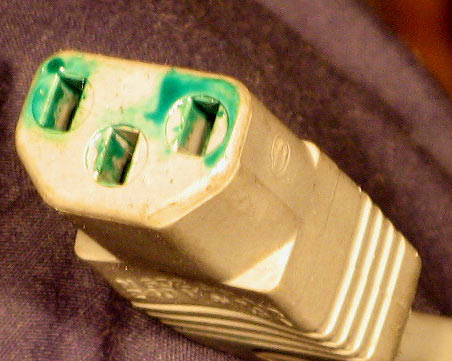Regular readers will know that the world currently teems with "power saving" devices, which are alleged to use Power-Factor Correction to save you money on your electricity bill.
These things are absolutely excellent, except for four minor flaws.
One, little plug-in PFC gadgets don't actually correct power factor at all, two, little plug-in PFC gadgets don't actually correct power factor at all, three, domestic electricity customers aren't billed by power factor anyway, and four, domestic electricity customers aren't billed by power factor anyway.
I realise that, technically speaking, that's only two flaws, but I thought they were such big ones they were worth mentioning twice.
At the other end of the commercial spectrum from the BS plug-in power savers, there are big industrial units designed to correct the atrocious power factor of certain particularly serious offenders, like really big electric motors, or really large numbers of smaller motors. Usually these sorts of correction setups are just capacitor and/or inductor banks carefully matched to the load; sometimes they're "smart" devices that adjust themselves to correct varying power factor, which is what you'll get if, for instance, you've got a factory full of big motors that keep changing speed and load.
This sort of PFC, and similarly large-scale PFC that's implemented by the actual power companies (typically in the form of big capacitor banks at substations and other distribution transformers), is entirely genuine, quite useful, and very expensive. But if you're billed by power factor, or if you're a power company that wants to minimise the mass of metal in your whole distribution network, PFC is essential.
In between the little rip-off plastic home-user things and the vast custom capacitor banks in power stations are, as you'd expect, PFC devices for medium-load applications. Yesterday I corresponded briefly with someone who's trying to sell such devices.
Regular readers won't find anything very new and exciting in this correspondence, and I wouldn't blame any reader for only lightly scanning at least the first giant block of quoted text. I'm posting this mainly so that Google searchers will be able to find a little more info about this field in general, and this product in particular.
(Also, I've suffered for my art, so now it's your turn.)
From: Tim Otto <tim@powerceosales.com>
To: dan@dansdata.com
Subject: Active and dynamic PFC.
Date: Wed, 3 Mar 2010 20:15:51 -0600Dan, I was reading your article and wanted to share with you our new technology. I agree with you on a residential level that the current PFC units don't save you money ,but when you take PFC and only put it in the circuit and remove it there is a savings. I am reaching out to all the blogger on the net and am asking them just to consider that what I'm saying is real. We have seen savings and when the product which just went to mass production get here I am reaching out to all bloggers on all continents to get a unit in their hands. I don't want to sell it to you. It will sell its self when you see it work. On the business side the meters do read different here in the states and the savings is much greater. Please take time to read the PDF study and when we hit your continent we can get one installed for your testing.
Why is power factor correction an important part of reducing co2 emissions and is there any new technology available to ad to the global effort? Yes, let me explain where this large void is occurring. Large industrial power users (demand side) have been using power factor correction (pfc) for years on large motor driven equipment because its too costly paying the power providers for this wasted reactive energy (poor p.f.). There is a demand (penalty) charge on their monthly bill including all commercial users. Several companies build PFC units by incorporating capacitors in various amounts to match the loads of running motor(s) to offset this penalty. These units are large and tailored to do a cost saving job for this industry. The user and power provider both see a power usage benefit.Home and commercial users share the burden of poor power factor and extra power must be provided to offset this waste. Air conditioning, furnace blowers, refrigerators, freezers, washers, dryers, fans, garbage disposals, dishwashers, lighting with ballast or transformers, pool pumps etc all ad to the burden. Whitby Hydro Energy Services of Canada did a series of test in 2005 by taking a group of homes and using pfc devices with a set amount of capacitance. Their conclusion: ‘The result of the pilot indicated that the addition of capacitance indicate that installation of the units on mass will reduce the generation requirements through the province and we recommend that the findings of this pilot be shared with the government officials as a viable means to help address the supply and transmission issues within the province”. The full 15 page PDF report is attached.
[The above quote isn't quite what the report actually says, but it's basically correct. Yes, the report does actually use the term "on mass". Hey, give 'em a break - they're in Ontario. Nobody speaks French there.]
No doubt Whitby Hydro could save on power generation so why not mandate to use pfc units on homes and business and save a new power plant from being constructed? To make this possible a pfc unit would have to turn on and off when motors and ballast/transformer type lighting were operational and make constant capacitance adjustments to correct the different loads and voltage fluctuation drops caused by peek demands. A good pf correction is .95-.96 and going higher can cause frequency modulation problems. Present pfc units are fixed or variable and cannot perform the computerized functions that would be required. This is where Power-CEOtm (Computerized Energy Optimizer) fills this gap. Our patented (USA and most countries) power factor correction units is the first to incorporate the proper technology for global usage. Here is what the patent-holder has to say: “We are confident that our patented “Power-Factor-Correction” technology is light years ahead of the other PFC systems. By and large, most PFC systems are either “Static” (designed for a specific amount) or a hybrid of “Limited Automatic,” designed around several variables and are thus referred to as automatic. However, our power-factor-correction technology is fully and completely Dynamic/Automatic in that it will turn on precisely the amount of correction required in order to attain a PF of .95 and not only that, in the event an additional load turns on or is introduced into the system requiring additional compensation, our Smart System will automatically and instantly adjust to the new required setting. When any load which was requiring the compensation either turns off/on or changes its setting (for example, motors with varying loads), our PFC system will readjust and continue to readjust as needed in order to provide as near to a PF setting of .95 continuously as is feasible.
The current US President, as well as our previous President both stated when talking about the Kyoto Protocol and Copenhagen Meeting on the Environment, that they believe technology will be developed which will help us reach ascertainable goals without significantly hampering commerce. As you will see, Power-CEO™ is one of those technologies.”Midwest Research Institute, a Government funded institute, has been involved since
2001 helping with technology issues until Power-CEO was completely viable and ready to market, and UL approval has been met. Plamen Doynov the senior engineer from MRI has this to say: I am intrinsically familiar with the technology. I was involved in the development of the original analog implementation during a contract with McDaniel brothers. Consecutively, we performed performance testing of the digital implementation of the technology. A copy of the performance report can be provided. In the report one can see that the testing of the technology confirms that it performs very well as a dynamic power factor correction unit. I am not writing this email as a representative of MRI. As an independent, not-for-profit, contract research institute, MRI has a strict policy not to endorse products, technologies, or cervices. Given an opportunity, MRI has the capacity to test and evaluate very broad technologies and systems. Should you need assistance from MRI in testing, evaluation, or further enhancements of the Power-CEO, I can facilitate the arrangements. Plamen DoynovPower-CEO is ready for production and can comply to any world specification. Power-CEO is ready to meet the demands of lowering power consumption.
[Attached was a PDF report from Whitby Hydro Energy Services, "Power Factor Correction at the Residential Level - Pilot Project", which is available from here, and quickly viewable in-browser here.]
My reply:
I agree with you on a residential level that the current PFC units don't save you money ,but when you take PFC and only put it in the circuit and remove it there is a savings.
I'm not sure what you mean by that. By definition, there's only a saving for people who are billed by power factor, or for people who are in the business of generating and transmitting electricity.
On the business side the meters do read different here in the states and the savings is much greater.
I'm also not sure what you mean by this :-).
There is a demand (penalty) charge on their monthly bill including all commercial users.
Really? How's a "commercial user" defined, then?
The local corner store here is unquestionably a commercial electricity user. I don't think they're billed by power factor.
Home and commercial users share the burden of poor power factor
Yes, in the indirect sense that power in general is made more expensive when electricity utilities have to cope with higher kVA than kW. But no home user will achieve any direct savings by improving their own power factor.
Whitby Hydro Energy Services of Canada did a series of test in 2005
...in which, according to the PDF you attached, they had to install special meters at the homes in order to see any difference, because of course the standard electricity meters do not measure power factor.
Even if all of the houses connected to the tested transformers were directly billed by power factor, though - so if your power factor is 0.9, you pay 1.11 times as much as someone with a PF of 1.0 - the reported improvements in the two transformers with the PFC added would only reduce consumers' power bills by less than 5% and less than 3%, respectively [I averaged out the five tested months in the PDF report].
There'd have to be a penalty rate far in excess of the actual extra volt-amps used to make it attractive to install a PFC system that cost more than a very small amount.
What does your product actually cost? How large would a customer's current power bill need to be to pay your product off in, let's say, five years, assuming it somehow allows that customer to reduce their power bills by even 5%?
No doubt Whitby Hydro could save on power generation so why not mandate to use pfc units on homes and business
Uh, because people don't want to buy expensive things that won't save them, personally, any money :-)?
I am unconvinced that widely-distributed household PFC installations, as opposed to the PFC systems already being installed in electrical substations, are a cost-effective proposition, even if you make them mandatory and have the taxpayer pay for them.
As a "retail" product for voluntary installation by homeowners, they appear to be a total non-starter.
A good pf correction is .95-.96 and going higher can cause frequency modulation problems.
Wait - so now you're saying that the 99.22% and 97.5% five-month average figures from the Whitby Hydro transformer study (versus 94.7% for an unmodified transformer) are undesirable?
The Power Medix device mentioned from page 11 of the PDF you sent apparently went considerably above 96%, as well. I find the figures there rather questionable, though; uncorrected power factor is way down in the .75 to .80 range at night. If that's the result of a water heater or geothermal heat pump or something, clearly that one something is what the power company should be giving that household a free power-factor corrector for, not the whole house.
If your special patented product carefully keeps the PF close to 0.95 at all times, I don't see that there's much of an improvement to be gained. Even if domestic consumers people start being billed by power factor. Which I doubt will happen any time soon, since it's hard enough to even explain what power factor IS to people, much less get them to re-elect someone who took their money because of it :-).
The current US President, as well as our previous President both stated when talking about the Kyoto Protocol and Copenhagen Meeting on the Environment, that they believe technology will be developed which will help us reach ascertainable goals without significantly hampering commerce.
I wouldn't say that in the press release, if I were you. We both know that few-per-cent improvements in power factor are not at all the sort of thing that heads of state are talking about when they make speeches like that.
Your repeated use of the word "patented" as if patents are only awarded for worthwhile inventions seems to me to be another unfortunate tactic.
Power-CEO is ready to meet the demands of lowering power consumption.
Another claim I think you should stop making.
A poor power factor, BY DEFINITION, does not mean that ANY more power is actually being consumed, except for the amount lost to resistance from higher current flows. That's significant for a power company, but vanishingly small for a home user. And even for most industrial users; they only care about PFC if they're billed by power factor.
In reply to this, all Tim sent me was:
Hears a link ,see what the power company has to say.
Also has anybody done a test where every item was corrected in a structure ?http://www.psnh.com/Energy/ReduceBill_Business/PowerFactor.asp
My reply:
Hears a link ,see what the power company has to say.
That page says:
How correcting power factor can save money
The PSNH demand charge is based upon kva demand for LG customers and upon 80 percent of the kva demand for GV (Commercial and Industrial) customers who have a power factor of less than 80 percent. Power factor correction may offer a savings opportunity for some customers.
"LG" is one of PSNH's "Large Business" tariffs, for "demands in excess of 1,000 KW" (PDF; domestic power consumption is more like 1 to 2 kilowatts, depending on what sort of "average home" you're looking at).
Small businesses are only even possibly affected by these issues if they actually have a low power factor, which outfits that aren't running lots of low-power-factor gear - typically, large motors without PFC capacitors already on them - will not have.
Stores with a huge bank of fluorescent lights may have a lousy enough power factor to be interested by this, but I think modern electronic ballasts have largely solved that problem. The same goes for computers; PCs used to have a pretty consistent 0.7 to 0.8 power factor, which could add up for a whole office full of them, but nowadays most PC PSUs have PFC built in, for exactly this reason.
Also has anybody done a test where every item was corrected in a structure ?
Only if the power factor is actually low enough to make the cost of correction attractive, which in normal domestic situations it is not.
Homes that draw a lot of power often draw it for things like electrical heating, which is almost entirely a simple resistive load with a power factor of 1. And in any case, to say it one more time, no homeowner is going to be interested in PFC if they're not billed by power factor. I am not aware of any nation in which private homes are billed by power factor. You'd think that there'd be some huge housing developments that were billed that way, but if there are, I haven't discovered any.
Since you did not choose to answer my questions, I can only presume that you have no answers for them. Sorry, but I cannot take further time to correspond with you if you're not actually offering anything new.
I don't know what the deal is with people like Tim. He doesn't seem to be deliberately running a scam, but he also keeps saying that products like his are for some reason going to become popular for home and small commercial electricity users. Those users don't actually have any reason to install a power-factor corrector unless they feel philanthropic toward the power company.
And if you do want to do the power company, or the planet, a favour by taking some load off the electricity grid, a much better idea for domestic power consumers is to look into a grid-connected solar system, which can genuinely reduce your power bill.
In many countries, new home solar-power installations are heavily subsidised by the government, for either purchase price, feed-in tariffs, or both. You may also be able to get a subsidy if you install a solar water heater, which is a simpler and less expensive investment than a photovoltaic solar electricity system.
Even if you can get a power-factor corrector for free, though, there's absolutely no point installing it unless you are for some reason using quite a lot of power, with a lousy power factor. Even houses that use a lot of electricity - electric heating in cold climates, big air-conditioners in hot countries, a giant bank of metal-halide lamps in the garage for some reason - don't necessarily have a lousy enough power factor for any add-on PFC to be necessary.











